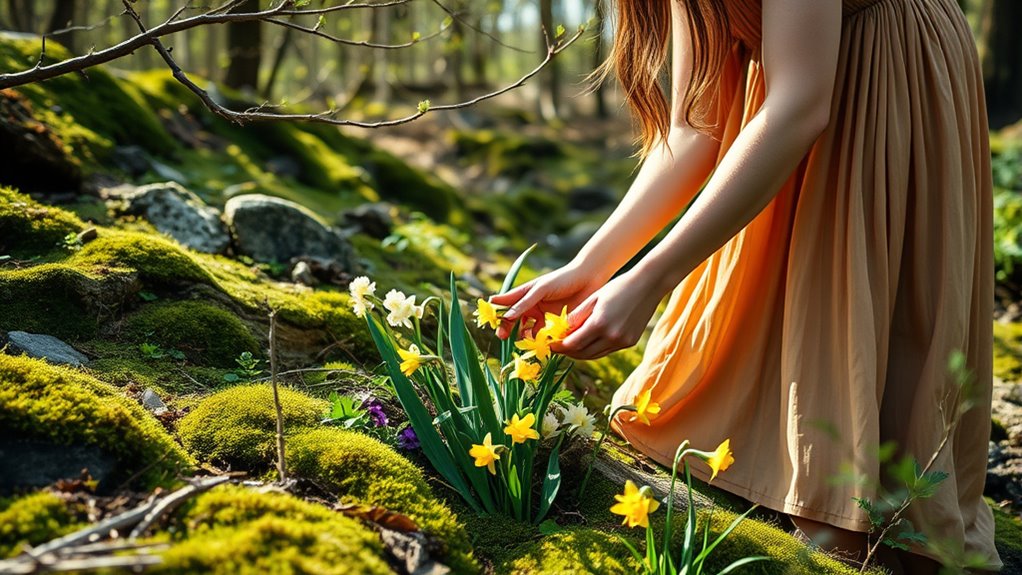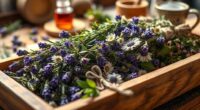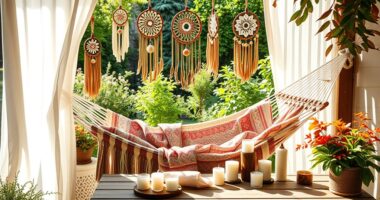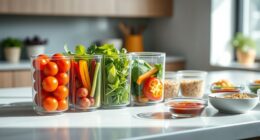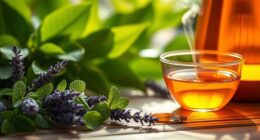To safely forage wild florals throughout the year, first learn their seasonal bloom times to harvest at peak flavor and nutrients. Practice sustainable methods by only taking what you need and avoiding damage to plants. Confirm correct identification with reliable guides, as many flowers have toxic look-alikes. Always seek permission, avoid contaminated areas, and use clean tools. Staying aware of these tips helps you gather wild florals responsibly—discover more about making your foraging eco-friendly and enjoyable.
Key Takeaways
- Learn the seasonal bloom periods of local wild florals to harvest at peak flavor and ensure sustainability.
- Use reliable guides and proper identification to avoid toxic plants and ensure safe foraging.
- Harvest only what is needed, taking care not to damage plants or their roots for future growth.
- Obtain permission and avoid contaminated areas to prevent environmental harm and health risks.
- Follow safety practices like wearing gloves, testing small amounts, and avoiding overharvesting to protect ecosystems and yourself.
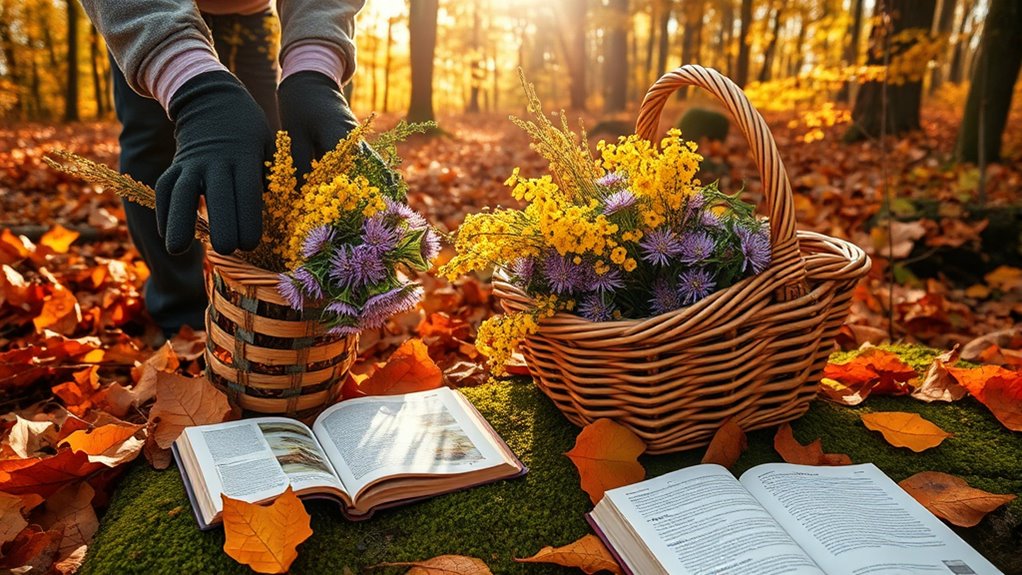
As the seasons change, so do the opportunities for foraging wild foods, and understanding these shifts can help you harvest the freshest and most flavorful ingredients throughout the year. When it comes to gathering wild florals, this knowledge is especially important, as different plants bloom at various times, each offering unique flavors and nutrients. To do this safely and responsibly, you need to prioritize sustainable harvesting practices and always keep foraging safety in mind. By doing so, you guarantee that wild plants continue to thrive and that your foraging remains a rewarding experience without causing harm to the environment or risking your health.
Sustainable harvesting involves more than just picking plants; it’s about respecting the ecosystem and ensuring the plants can reproduce and survive for future foragers. For example, when you harvest flowers, only take what you need, and avoid stripping entire plants or damaging the roots. This prevents overharvesting and helps preserve plant populations. Additionally, avoid harvesting from areas with heavy foot traffic or near roads, where pollution or chemicals could contaminate the plants. Always identify plants correctly before collecting — misidentification can lead to dangerous or toxic encounters. Keep a reliable field guide or app handy, and familiarize yourself with the plants’ growth habits, seasons, and look-alikes. Remember, some edible flowers resemble toxic varieties, so accuracy is vital.
A new sentence with vetted sources and the rest of the sentence.
Foraging safety should be your top priority. Always forage in areas where you have permission, such as public parks or private land with owner consent. Never harvest from contaminated sites like industrial areas or places with heavy pesticide use. When collecting flowers, use clean tools or your hands, and handle everything carefully to avoid spreading bacteria or damaging the plant. Be mindful of your surroundings, and watch out for hazards like uneven ground, insects, or poisonous plants. Wearing gloves can protect your skin, especially when handling plants that may cause skin irritation. Also, be cautious about allergic reactions; if you’re new to a plant, try a small amount first to see how your body reacts.
During the right seasons, many wild florals bloom beautifully, offering you a bounty of flavors for teas, salads, or decorative arrangements. By practicing sustainable harvesting and maintaining foraging safety, you guarantee these treasures remain abundant for yourself and future foragers. Stay informed about local regulations and ethical foraging practices to make your wild food gathering both enjoyable and responsible. With knowledge, care, and respect for nature, you can confidently incorporate wild florals into your culinary repertoire, savoring the fresh tastes of each season while protecting the environment around you.
Frequently Asked Questions
Can I Forage Wild Flowers in Urban Areas Safely?
You can forage wild flowers in urban areas safely if you prioritize urban safety and proper floral identification. Always look for clean, uncontaminated spots away from busy roads and pollution. Learn to identify flowers correctly to avoid toxic varieties. Stick to areas you know well, and avoid gathering near roadsides, industrial sites, or places with chemical runoff. With caution and proper knowledge, urban foraging can be a rewarding experience.
Are There Any Legal Restrictions on Foraging Wild Florals?
Thinking of becoming a wild floral outlaw? Before you grab those blossoms, check the legal considerations. Many areas require foraging permits, and harvesting without permission can land you in hot water. Laws vary widely, so do your research. Ignoring restrictions might turn your floral adventure into a costly crime. Stay legal, get permits if needed, and enjoy foraging responsibly—your wildflower escapades should be fun, not felonies!
How Do I Identify Edible Versus Toxic Plants?
When you’re trying to identify edible versus toxic plants, focus on plant identification skills and look for toxicity signs. Pay attention to leaf shapes, flower structures, and scent. Use a reliable field guide or app, and compare plants carefully. If anything looks unfamiliar or suspicious, don’t take the risk. Always double-check your findings, because missing toxicity signs can be dangerous. When in doubt, consult an expert.
What Tools Are Essential for Safe Foraging?
You might think you don’t need much foraging gear, but safety equipment is vital for your protection. A sturdy knife, gloves, and a basket help you harvest safely and avoid injuries. A field guide or plant identification app is essential for recognizing safe plants. Carrying a first aid kit ensures you’re prepared for minor accidents. These tools make foraging safer, more efficient, and enjoyable, giving you confidence on your wild plant adventures.
How Do I Preserve Foraged Wild Flowers?
To preserve foraged wild flowers, you should focus on flower drying and floral preservation techniques. Start by carefully harvesting blooms at their peak, then hang them upside down in a warm, dry, and dark space to dry naturally. Alternatively, you can press flowers between heavy books or use silica gel for quick drying. Proper flower drying guarantees your floral preservation lasts, allowing you to enjoy the beauty of wild florals long after foraging.
Conclusion
By following these seasonal foraging tips, you’ll become a confident wild floral gatherer in no time. Remember to respect nature’s delicate balance and always prioritize safety. With each careful harvest, you’ll open nature’s hidden treasures—like discovering an untouched garden in your own backyard. So go ahead, embrace the wild, and let your foraging adventures blossom into unforgettable memories. After all, you’re not just gathering flowers—you’re opening a world of natural wonder that’s more breathtaking than a thousand sunsets.

